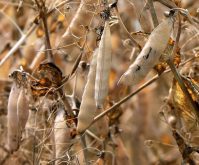CNS Canada — Strong demand for Canadian flax, combined with small production, has driven prices up, which could tempt producers making seeding choices this spring.
Last year, the amount of flax seeded in Canada was down about a third from the previous growing season. As a result, stocks are short, despite large carryover.
Demand, however, is on par with bigger crop years, said Don Kerr, president of the Flax Council of Canada.
Earlier this year, Europe changed its maximum reside limit for the herbicide haloxyfop, curbing demand for Russian and Kazakhstani seed, creating a gap that Canada’s crops are able to fill.
Read Also

U.S. livestock: Cattle make small gains, hogs fall
Chicago cattle futures made modest gains on Monday while hogs pulled back. Most-active February live cattle closed at 230.550 cents…
Exports to China are expected to stay the same as last year, Kerr said, estimating that level at around 350,000 tonnes.
“Even though we’re seeing increases with some of that Kazakhstani seed leaking into China,” he said.
Kerr expects demand from the U.S. to be lower, as the country increased production last year.
That demand has put delivered elevator flax prices between $11.75 and $12.28, up $1.23-$1.44 per bushel on the year, according to data from Prairie Ag Hotwire. New-crop prices are in the $12.50 a bushel range in Western Canada.
Profitability is a key factor farmers consider when deciding what crops to grow, which means flax may see increased acres this year.
“I think there could be a rebound in acres in Manitoba this year, simply because prices have improved,” Kerr said, adding flax in the province will likely be competing with soybeans.
However, growth in Manitoba is expected to be limited, especially compared with Saskatchewan.
A large majority of flax acres is grown in Saskatchewan, and last year’s sharp declines were partially due to large pulse production.
India is expected to implement an edict that would require Canadian pulses to be fumigated at the port of origin, hurting demand from the country.
“So we may see a bit of an increase in flax acres in Saskatchewan this year,” Kerr said.
“And we might see a slight reduction in pulses because we saw such a huge increase last year.”
Flax production will likely not hit the pace seen two years ago, Kerr added. “I think it’s going to be tough to get back to that level.”
Agriculture and Agri-Food Canada’s most recent grain and oilseed supply and disposition report pegs this year’s estimated seeded flax acreage at 1.05 million acres, compared with last year’s 930,000.
— Jade Markus writes for Commodity News Service Canada, a Winnipeg company specializing in grain and commodity market reporting.















